Hazardous Trees
Operational Protocol
Scope
This Operational Protocol outlines the identification, marking and mitigation of hazardous trees and/or tree hazards, as well as significant trees, and must be followed when working in or around areas with these trees. Areas may include (but are not limited to) incident grounds, prescribed mitigation activities, training activities, inspections, community education and social activities, assembly areas, or base camps.
Fundamental Protocols underpin the actions of all NSW Rural Fire Service (RFS) members and must be adhered to at all times. They outline the Principles of being an RFS member and provide guidance on conduct to support the safety and wellbeing of members.
Protocol
This RFS protocol, provides a common and coordinated approach for interagency involvement in hazardous tree and/or tree hazard management, and aligns to the Joint Agency Guideline used by: NSW National Parks and Wildlife Service (NPWS), Fire and Rescue NSW (FRNSW), and Forestry Corporation NSW (FCNSW).
Hazardous Tree Identification
- Hazardous trees and/or tree hazards are defined as a tree, limb or branch that is expected to fall within the timeframe of the current operation and have the potential to impact personnel, infrastructure, or appliances.
- The incident area where crews will be working or travelling through should be inspected prior to the commencement of each shift, where practical and appropriate, and continually reassessed throughout the incident. As conditions change and fire passes through an area, trees in the vicinity can quickly become hazardous, and personnel must remain vigilant, looking out for the next significant risk.
- Always conduct the identification and assessment of tree hazards from a safe distance.
- Investigate whether the incident area has previously been identified as high-risk for trees; and/or whether local knowledge, ground observations, and/or aerial observations (if available) indicate the area is dominated by hazardous trees and/or tree hazards.
- It is the responsibility of all personnel within the incident area to identify any suspected hazardous trees and/or tree hazards. Once identified, hazardous trees and/or tree hazards should be clearly marked, and where possible an exclusion zone established. The occurrence of identified hazardous trees and/or tree hazards must be communicated to all personnel in the incident area and escalated to the Incident Management Team (IMT) and/or Safety Advisor (SA).
- Identified hazardous trees should be logged and shared in FireMapper.
Risk Management
- Only trained and experienced personnel should determine the method of control and priorities for managing hazardous trees and/or tree hazards. Consultation and notification to the Incident Controller (IC) and District Duty Officer (DDO) for small scale incidents, or IMT and SA for incidents where these positions have been established. These are essential in determining the appropriate course of action for dealing with hazardous trees and/or tree hazards.
- If identified hazardous trees are also significant habitat trees or culturally significant trees, this should be considered when determining an appropriate control method. Consultation with local knowledge holders or specialists should also be considered.
- Control methods may include a combination of:
- Communication – during briefings, ensure all personnel are advised and aware of the location of all hazardous trees and/or tree hazards, and understand the risks posed by them.
- Locating - Mark and update maps, Incident Action Plans (IAP), Prescribed Burn Plans (PBP), FireMapper, and other relevant materials to indicate locations of hazardous trees and/or tree hazards.
- Keep personnel away from the tree – clearly mark the hazard and establish an exclusion zone. Consider physical barriers or avoidance/isolation where appropriate.
- Move operations to avoid the tree – such as constructing a fire containment line if safe and appropriate.
- Construct a mineral earth break around the hazardous tree where safe and appropriate and always apply appropriate lighting techniques to reduce the likelihood of tree ignition. Support for rapid extinguishment of any new ignition must be considered.
- Let the tree burn out if safe and appropriate.
- Extinguish the tree if safe and appropriate.
- Remove the tree – by either heavy plant or manual tree felling methods if safe and appropriate. Tree felling after dark is not recommended and should only be considered in exceptional circumstances. In such instances, sufficient lighting to illuminate the entire work area (including areas where logs/trees will move to when cuts are made) and tree canopy must be provided.
- Where a hazardous tree is on fire, a risk assessment must be conducted to determine if it is safe and appropriate for the tree to be felled. Heavy plant should be considered as the first option, with felling by hand (such as chainsaw) considered as a last resort. Refer to RFS OPG - Chainsaw Operations.
- Where it is determined not safe or appropriate to fell a hazardous tree that is on fire, members must mark an exclusion zone and let the tree self-extinguish or fall. Construction of a wide break (e.g. minimum two tree lengths) and burn out around the tree may be appropriate in some circumstances.
- For prescribed burns, the area should be inspected for hazardous trees and/or tree hazards prior to the introduction of fire, with special attention to hazardous trees and/or tree hazards with the potential to impact control lines if they were to fall or fail. These trees should be cleared around, isolated, or removed, to minimise the potential for fire to impact them.
- If time and resources permit, similar attention should be paid to the protection of significant trees from damage within the incident area.
- There are a number of risk control measures that can be undertaken prior to, during and after an incident. Refer to Appendix Two.
- If an exclusion zone occurs across a trail or control line, a decision to close this route and use an alternate route or control line must be considered. Where it is not practical to avoid the area, safe work practices must be developed and communicated to limit firefighter risk exposure.
- Tape should be used as a barrier to restrict access to the exclusion zone. Red and white striped tape must be used to mark an exclusion zone. If tape is not available or to make an exclusion barrier more effective, utilise other available materials to clearly mark an exclusion zone. Refer to Appendix Three.
Symbology and Exclusion Zone
- When a hazardous tree is identified, it must be marked with a circle with a cross through it, if safe to do so. This is the only hazardous tree symbol that is to be used in NSW. Refer to Appendix One.
- All identified hazardous trees must be marked or be within an exclusion zone. Yellow paint should be used to mark hazardous trees, consistent with national standards. When safe to mark a hazardous tree, the following rules apply:
- Where possible, biodegradable paint should be used;
- Mark on two sides of the tree if it is safe to do so;
- If it is not safe to mark a tree, an indicator tree(s) should be marked;
- Tree marking should be 30 cm in diameter, if the tree size allows;
- The symbol should be clearly visible from the control line and all access routes;
- The symbol should be 1.5 m off the ground;
- Paint must not be applied to rocks or rocky outcrops; and
- If paint is not available, tie one loop of tape around the tree at chest height.
- If unsafe to mark a hazardous tree, an indicator tree is to be identified. When using an indicator tree, the following rules apply:
- Use the hazardous tree symbol on an indicator tree(s) with an arrow pointing to the tree and a distance written.
- If paint is not available, tie one loop of tape around each indicator tree at chest height then angle tape from the loop to the ground pointing to the location of the hazardous tree.
- Identified hazardous trees and/or tree hazards are to be marked on relevant maps, IAPs and PBPs.
- The exclusion zone is the area around a hazardous tree and/or tree hazard that is not safe, where the tree could fall at any time and may cause serious injury or death. Refer to Appendix Three.
- The exclusion zone of a hazardous tree is a minimum of two tree lengths of the tree. Where the area presents unique circumstances, such as ground slope or the tree has a recognisable lean, the exclusion zone should be calculated as 180 degrees from the tree in the applicable direction. In all situations, an ongoing Dynamic Risk Assessment (DRA) should be conducted to identify changing circumstances and emerging hazards.
- Where practical, all firefighters and personnel should avoid working or travelling through any exclusion zone until the risk from a hazardous tree and/or tree hazard has been treated.
Notification and Handover
- Identified hazards must be immediately escalated to the relevant personnel, starting with those in the immediate vicinity when first observed, then all personnel on the incident ground, the IC/IMT and the SA.
- When a hazardous and/or culturally significant, historic, significant or habitat tree is identified and assessed, it must be escalated to the relevant IC and SA, and recorded in logbooks and on relevant maps, IAPs and PBPs.
- A Special Safety Warning is to be broadcast through all relevant channels in the incident area, highlighting the location of the hazard and any specific actions required. Information must be communicated in subsequent briefings.
- Hazardous and/or culturally significant, historic, significant or habitat tree identification must be highlighted as part of ongoing safety and shift briefings.
- At the completion of an incident where practical, the landowner/manager should be given an update on any hazardous trees and/or tree hazards, and their locations. Where safe and appropriate, a joint visual inspection of the tree may be conducted as part of the handover.
Special Considerations
Characteristics of Hazardous Trees
- Trees, stumps, limbs, and branches can all constitute a tree hazard, and pose a potential health and safety risk for personnel undertaking activities at the incident area.
- Signs and characteristics that may indicate a potential tree hazard:
- Trees with hangers or damaged limbs that could fall and impact personnel in planned work areas or access routes;
- Indicators that recent change has occurred to a tree should be inspected to determine whether structural integrity has been compromised;
- Trees with new or fresh longitudinal cracks in the timber or bark (particularly if they have occurred after a burn);
- The presence of new ash deposits at the base of trees and/or new charcoal in unburnt areas immediately adjacent to (or on) the control line;
- Swelling on the trunk or at branch joints, that may have been caused by healing from past impacts to the tree, may be an indicator of reduced integrity;
- Trees affected by one or more of the following: excessive rot content; exposed root systems; root, trunk or stem damage; storm, flood, snow or fire damage; impact by machinery, snigged logs or insect attack;
- Trees with shallow root systems in unstable, eroded, or steep ground;
- Dead trees;
- Trees with excessive lean or an obvious lean towards the work area or trees with potential to fall on to other trees and impact the work area;
- Trees with the following characteristics are described in Appendix Four:
- Pipe;
- Dry Side;
- Hollowbutt;
- Hollows;
- Dead Crowns;
- Widow Makers;
- Dead Stags and Spars; and
- Hang-ups.
- Some trees with the above characteristics, if protected from fire, can be prevented from becoming hazardous. Wherever possible, these trees should be protected by clearing around the base, and the use of low intensity ignition techniques.
- There are also external influences that may increase the potential for a tree to become hazardous. These include:
- Impact of fire;
- Wind exposure, where there has been a change to exposure due to tree removal or potential for unusually increased wind exposure (speed and/or direction) due to weather or geography;
- Snow in tree canopy that may obscure stem damage, or the weight of snow may cause failure;
- Drought or sodden soils, leading to increased risk of tree hazard in some vegetation types;
- Stress and insect infestation;
- Excessive drainage problems from land management operations e.g. snig tracks in forestry operations; and
- Exposure to impacts and vibration from heavy plant or machinery.
Conservation
Tree Conservation
- While safety of personnel in an incident area is paramount, at all times conservation of trees must be considered and managed appropriately. Trees should not simply be removed unless an unavoidable danger or risk is posed to personnel or operations in an incident area.
Culturally Significant, Historic and Significant Trees
- Trees that are culturally significant to Aboriginal people (e.g. modified trees such as scar trees and carved trees), trees with historic significance (e.g. Explorer trees or Surveyor trees), and significant trees (e.g. trees identified on the National Trust Significant Trees Register or a Council Significant Trees Register) should be protected from the impact of fire, and actions taken to protect the tree where possible.
- Culturally significant trees may display attributes such as decoration to mark burial site, wounding and/or scarring of bark for coolamon, shield, or canoe manufacture. Historic and significant trees may also have some form of scarring or markings. These trees may be old trees in declining health and vigour and be more susceptible to further damage from fire, flood, and storms.
- ICs and personnel on the fireground need to consider measures to protect culturally significant, historic, and significant trees. Such measures may include:
- Engaging local knowledge holders to assist the IMT with significant tree identification;
- Identification of significant cultural and historic trees on IAPs and PBPs;
- Clearing or use of foam around trees if environmentally and physically safe and practical to do so prior to the passage of fire. For hazard reduction works, all cultural and historic trees must be assessed as part of the environmental assessment process and managed accordingly);
- Exclusion of fire, tree felling and track construction in areas near cultural and historic trees; and
- Strong preference is to be given to extinguishing fires burning on cultural or historic trees or near them, rather than attempting tree removal.
Habitat Trees/Threatened Species
- Hollow bearing trees, including trees that are dead, are used as habitat for many other lifeforms. Tree hollows are used by mammals, birds, reptiles, amphibians, and invertebrates, as well as epiphytic plants and fungi, including some which are listed as threatened species. These habitat trees exhibit what are termed in arboriculture literature as ‘tree defects’, i.e. large cavities and hollows, dead branches, wounding, and decay, but which are also ecologically beneficial.
- Habitat trees may also be identified as current nesting or roosting sites for threatened species, such as owls or bats, and may be areas where disturbance should be avoided during certain times of the year.
- Bushfire or prescribed fire can more easily become established in such trees due to the presence of these features and may exacerbate the hazard, requiring attention by fire crews if the tree is located near an asset or poses a risk to safety or the further spread of fire.
- Some tree species are also identified as threatened species identified in the schedules to the NSW Biodiversity Conservation Act 2016. Other tree species may be identified as Assets of Intergenerational Significance under the National Parks and Wildlife Act 1974.
- Removal of dead wood and dead trees is listed as a Key Threatening Process under the NSW Biodiversity Conservation Act 2016, because it provides essential habitat for a wide variety of native animals and is important to the functioning of many ecosystems.
- ICs and firefighters should consider measures prior to, during and after the passage of fire through an area containing habitat trees or threatened tree species, to minimise the likelihood of these trees being impacted by fire and potential removal. Such measures include:
- Identification marking and treatment of habitat trees where safe and practical to do so, prior to the passage of fire; treatments might include the removal of fuel around the base of the tree, using low intensity ignition techniques, and/or use of water or limited use of foam when environmentally safe to do so;
- Strong preference is to be given to extinguishing fires burning on cultural, historic or habitat trees rather than attempting tree removal;
- If a tree is fire affected, provided it is safe and practical, the tree should be allowed to naturally self-extinguish. One of the impacts of fire in trees is to initiate or progress the establishment of hollows over time, creating new habitat niches. Marking of such trees and/or indicator trees as per the procedures listed above may be required.
Related Information
- FireMapper (In-Field Mapping) Project
- Joint Operational Guideline - Hazardous Trees
- National Parks and Wildlife Act 1974
- NSW Biodiversity Conservation Act 2016
- Planning for Bush Fire Protection 2019
- RFS OPG - Chainsaw Operations
- RFS OPG - Heavy Plant
- RFS OPG - Special Safety Warnings
Appendix One
Symbology

Appendix Two
Risk Control Measures
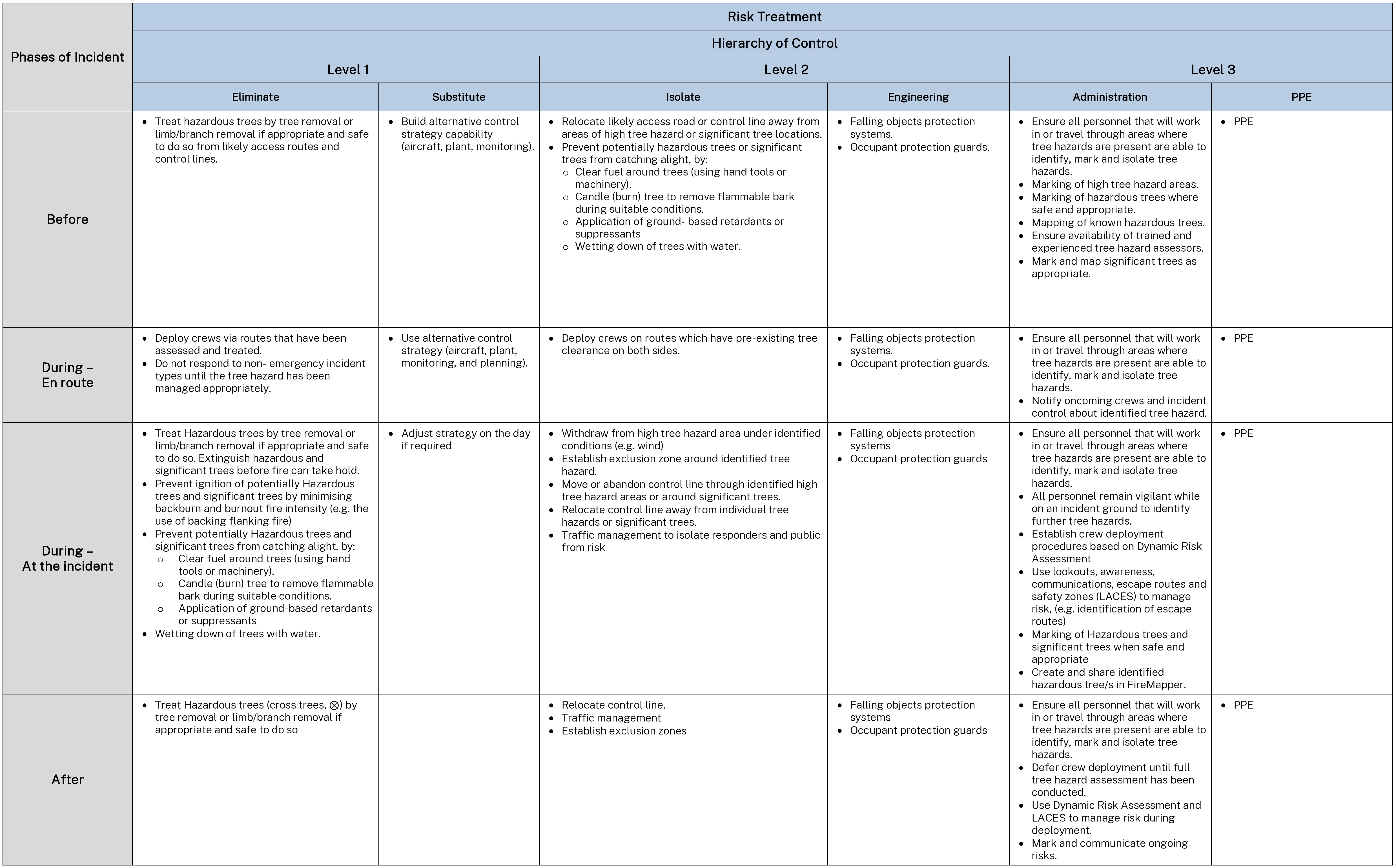
Appendix Three
Exclusion Zone

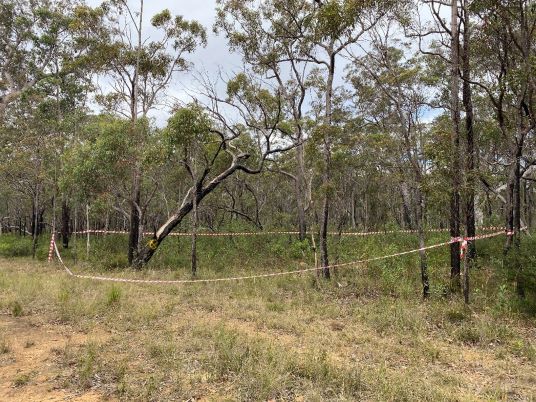
Physical Barriers
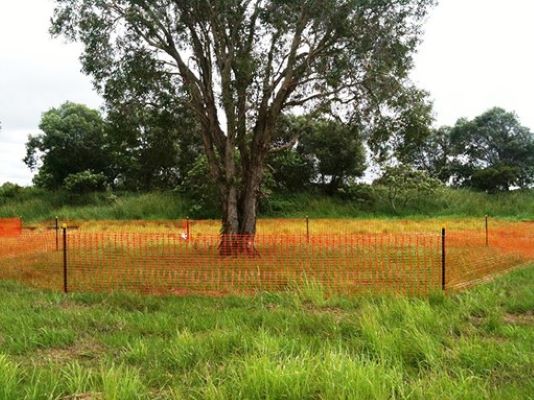
Indicator Tree Marking

Appendix Four
Characteristics of Hazardous and Significant Trees
Pipe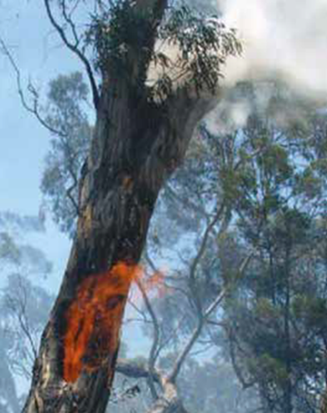 A Pipe or Chimney is formed inside the trunk when fire is able to burn the decayed heart of a tree. The entry of fire occurs via burnt out roots, dry sides or hollowbutts. Complete pipes have visible flames coming out the top. Incomplete pipes may only be evident by smoke coming out of the crown. | Dry Side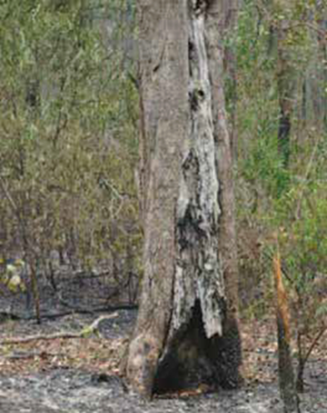 Dry side is an area of dead wood on the trunk of a tree usually caused by a previous fire or other damage, e.g. another tree falling against it. In combination with decay
or rot, dry side can result in hollowbutt. Dry side is an area of dead wood on the trunk of a tree usually caused by a previous fire or other damage, e.g. another tree falling against it. In combination with decay
or rot, dry side can result in hollowbutt.
| Hollowbutt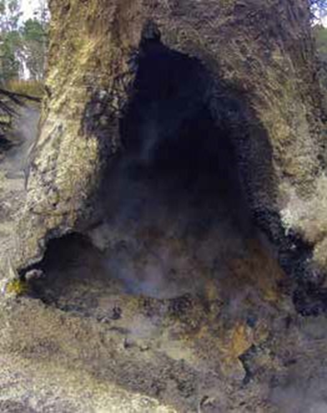 A hollowbutt is a tree that has a hollow at the base due to disease or damage. It may have also been burnt. There are often other faults such as significant rot
or heart decay providing a pathway for fire to travel up the tree. A hollowbutt is a tree that has a hollow at the base due to disease or damage. It may have also been burnt. There are often other faults such as significant rot
or heart decay providing a pathway for fire to travel up the tree.
|
Hollows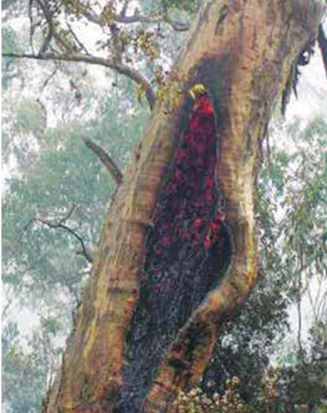 Hollows are formed by either rot or fire usually following structural damage of the tree, such as a limb breaking off. Hollows in the trunk or limbs vary in shape and
depth. Hollows are formed by either rot or fire usually following structural damage of the tree, such as a limb breaking off. Hollows in the trunk or limbs vary in shape and
depth.
| Dead Crowns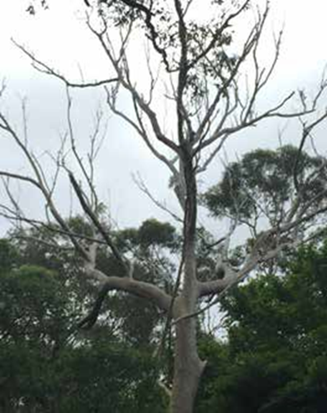 Dead crowns are often the result of a tree becoming over mature or from fire damage, snow damage, insect attack or disease. These trees contain a significant amount
of dead wood in their crowns. Trees with dead or damaged crowns are a key concern on the fire line as they are likely to burn longer, shower burning embers, and part or all of the crown may fall. Dead crowns are often the result of a tree becoming over mature or from fire damage, snow damage, insect attack or disease. These trees contain a significant amount
of dead wood in their crowns. Trees with dead or damaged crowns are a key concern on the fire line as they are likely to burn longer, shower burning embers, and part or all of the crown may fall. | Hang-ups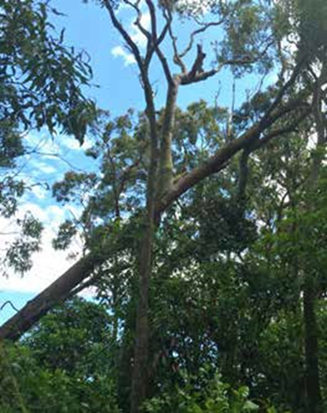 Occasionally a tree may fall and ‘hang-up’ on another tree. Hang-ups are particularly dangerous if leaning across a road or track but can be just as dangerous to firefighters
during mop-up. Hang-ups are often very difficult to get down safely by felling or pushing and if not leaning across a key work area the exclusion zone is best avoided. Occasionally a tree may fall and ‘hang-up’ on another tree. Hang-ups are particularly dangerous if leaning across a road or track but can be just as dangerous to firefighters
during mop-up. Hang-ups are often very difficult to get down safely by felling or pushing and if not leaning across a key work area the exclusion zone is best avoided.
|
Dead Stags and Spars Large dead trees are known as stags, while smaller dead regrowth is known as spars. When a stag is large it poses a significant threat, both
in duration of burning and the amount of burning material in the crown and are often difficult to extinguish. Large dead trees are known as stags, while smaller dead regrowth is known as spars. When a stag is large it poses a significant threat, both
in duration of burning and the amount of burning material in the crown and are often difficult to extinguish. | Widow Makers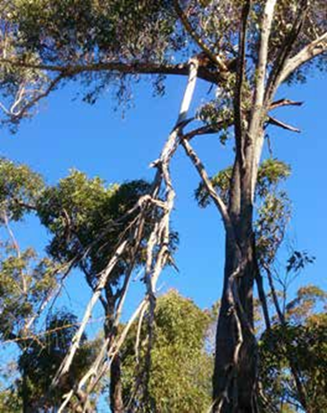 Widow Makers are limbs which are hooked up or tangled in other limbs. Widow Makers can be dislodged without warning and are more likely to fall during felling,
when burning or during wind. Widow Makers are limbs which are hooked up or tangled in other limbs. Widow Makers can be dislodged without warning and are more likely to fall during felling,
when burning or during wind.
| Scarred Trees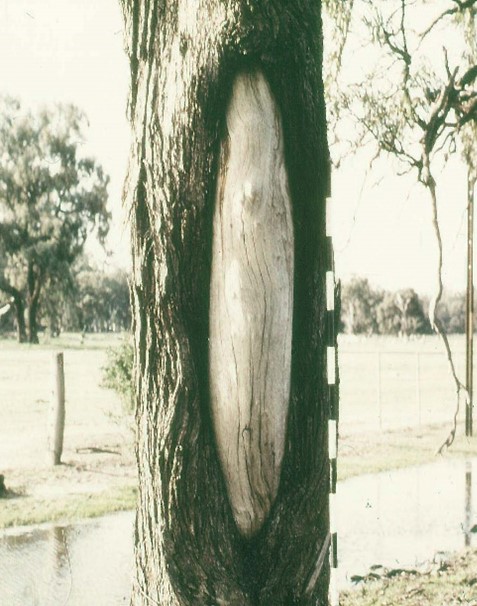 Scarred trees are trees that have had bark removed by Aboriginal people to make bark canoes, shelters, containers, shields, tools, or other artifacts. Scarred trees are trees that have had bark removed by Aboriginal people to make bark canoes, shelters, containers, shields, tools, or other artifacts.
|
Significant Trees Significant trees are trees identified on the National Trust Significant Trees Register or a Council Significant Trees Register, and are selected based
off their historical, cultural, social, or ecological meaning. Significant trees are trees identified on the National Trust Significant Trees Register or a Council Significant Trees Register, and are selected based
off their historical, cultural, social, or ecological meaning. | Carved Trees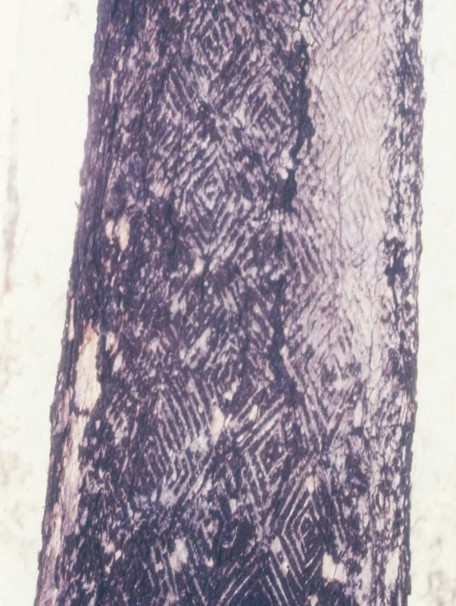 Carved trees were used as cultural markers and as a means of communication for Aboriginal people. Carved trees were used as cultural markers and as a means of communication for Aboriginal people.
| Habitat Trees Many species of animals use existing hollows, dead branches, tree roots, or other features, as shelter and homes. Many species of animals use existing hollows, dead branches, tree roots, or other features, as shelter and homes. |
Content Owner:
Area Operations
Date Approved:
16 Sep 2024
Review Required:
16 Sep 2027
Version:
1.1
If you have any questions or feedback on Operational Doctrine, please email Ops.Performance@rfs.nsw.gov.au.




